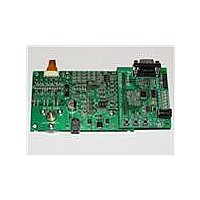APMOTOR56F8000E Freescale Semiconductor, APMOTOR56F8000E Datasheet - Page 81

APMOTOR56F8000E
Manufacturer Part Number
APMOTOR56F8000E
Description
KIT DEMO MOTOR CTRL SYSTEM
Manufacturer
Freescale Semiconductor
Type
Motor / Motion Controllers & Driversr
Datasheets
1.CWH-UTP-ONCE-HE.pdf
(2 pages)
2.APMOTOR56F8000E.pdf
(124 pages)
3.APMOTOR56F8000E.pdf
(2 pages)
Specifications of APMOTOR56F8000E
Accessory Type
Motor Controller
Input Voltage
9 V
Interface Type
RS-232
Product
Power Management Modules
For Use With/related Products
DEMO56F8013, DEMO56F8013-E
Lead Free Status / RoHS Status
Lead free / RoHS Compliant
6.7 Clocks
The memory, peripheral and core clocks all operate at the same frequency (32MHz max) with the
exception of the TMR and PWM peripheral clocks, which have the option (using TCR and PCR) to operate
three times faster. The SIM is responsible for stalling individual clocks as a response to various hold-off
requests, low power modes, and other configuration parameters. The SIM has access to the following
signals from the OCCS module:
While the SIM generates the ADC peripheral clock in the same way it generates all other peripheral clocks,
the ADC standby and conversion clocks are generated by a direct interface between the ADC and the
OCCS module.
Figure 6-16
of reset. RST is assumed to be the logical AND of all active-low system resets (for example, POR, external
reset, COP and Software reset). In the 56F8014 architecture, this signal will be stretched by the SIM for a
period of time (up to 96 MSTR_OSC clock cycles, depending upon the status of the POR) to create the
clock generation reset signal (CLKGEN_RST). The SIM should deassert CLKGEN_RST synchronously
with the negative edge of OSC_CLK in order to avoid skew problems. CLKGEN_RST is delayed 32
SYS_CLK cycles to create the peripheral reset signal (PERIP_RST). PERIP_RST is then delayed by 32
SYS_CLK cycles to create CORE_RST. Both PERIP_RST and CORE_RST should be released on the
negative edge of SYS_CLK_D as shown. This phased releasing of system resets is necessary to give some
peripherals (for example, the Flash interface unit) set-up time prior to the 56800E core becoming active.
Freescale Semiconductor
MSTR_OSC
HS_PERF
SYS_CLK_x2
illustrates clock relationships to one another and to the various resets as the device comes out
This comes from the input clock source mux of the OCCS. It is the output of the relaxation
oscillator or the external clock source, depending on PRECS. It is not guaranteed to be at
50% duty cycle (+ or - 10% can probably be assumed for design purposes). This clock runs
continuously, even during reset and is used for reset generation.
The PLL multiplies the MSTR_OSC by 24, to a maximum of 192MHz. The ZSRC field in
OCCS selects the active source to be the PLL. This is divided by 2 and postscaled to
produce this maximum 96MHz clock. It is used without further division to produce the
high-speed (3x system bus rate) variants of the Quad Timer and PWM peripheral clocks.
This clock is disabled when ZSRC is selecting MSTR_OSC.
The PLL can multiply the MSTR_OSC by 24, to a maximum of 192MHz. When the PLL is
selected by the OCCS ZSRC field, the PLL is divided by three and postscaled to produce
this maximum 64MHz clock. When MSTR_OSC is selected by the OCCS ZSRC field,
MSTR_OSC feeds SYS_CLK_x2 directly. The SIM takes this clock and divides it by two to
generate all the normal (1x system bus rate) peripheral and system clocks.
56F8014 Technical Data, Rev. 11
Clocks
81










